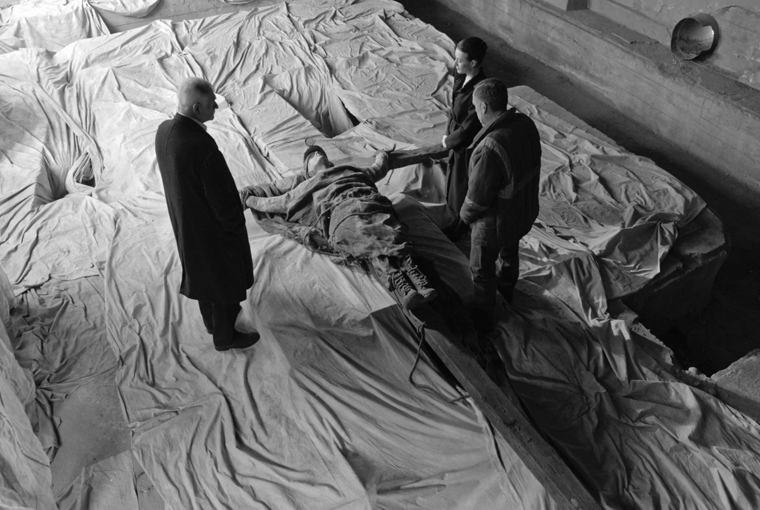Old World Order
Tinatin Kajrishvili’s Citizen Saint (Mokalake Tsmindani, 2023)
Vol. 138 (October 2023) by Martin Kudláč
Georgian director Tinatin Kajrishvili’s third feature Citizen Saint premiered as part of the main competition at the Karlovy Vary International Film Festival. Her monochrome drama delves into themes of spirituality, despair, and the complexities of the human condition and is set against the backdrop of Chiatura, a mining town in Georgia. The narrative draws inspiration from a historical figure who proclaimed himself Saint Nicolas, and later King Nariman. Kajrishvili navigates the dual-edged nature of hope – its capacity to both heal and destabilize, thereby creating divisions within communities.
The small mining town evokes a post-apocalyptic landscape as the film portrays an environment that has declined from its former prosperity into a state of decay. The remaining community, having foregone the opportunities presented by larger, more urban settings, largely comprises miners who persist in their subterranean work, signaled by the regular call of new shifts. Among the exceptions to this mining populace are several key characters: the elderly Berdo (Levan Berikashvili), who resides near the mine where his son perished in a collapse years earlier; his ex-wife (Lia Abuladze), a wandering figure in perpetual mourning; and Mari (Mari Kitia, previously honored with Sarajevo’s Best Actress award for her role in Kajrishvili’s Brides), who manages the local mining museum.
The miners adhere to a daily ritual of visiting a crucifix-mounted saint overlooking the mine to seek protection. This anonymous saint was locally canonized following a cave-in incident. According to local lore, the saint had performed miracles before being tortured, crucified, and left for dead. His body petrified, he was subsequently transformed into an object of reverence. Miners turn to him for safety, while local non-mining residents approach him to confess their sins and plead with him to hear them out.
In a screenplay co-authored by Tinatin Kajrishvili and writer-producer Basa Janikashvili, the saintly miner figure is removed from his mount and transferred to a nearby museum for restoration. This relocation causes unease among the miners. Tensions escalate in the dormant mining town when the revered statue disappears, leaving only the empty cross behind. Intriguingly, a mute stranger (played by George Babluani) arrives in town at the same time, leading the community to speculate that he may represent a second coming of their saint. Adding to the atmosphere of mystery, a series of unexplained events transpire: Berdo encounters his deceased son, and the mute stranger exhibits stigmata, further intensifying the community’s belief that the saint has manifestly returned.
Remaining unresponsive to questions and inquiries, merely offering a blank stare in return, the stranger is once again transformed into a symbolic figure. However, unlike his previous stone incarnation, his living form comes to represent not hope, but a perceived threat. The initial jubilation among the locals dissipates when they realize that they have not only prayed to him but also divulged their darkest secrets. The mere possibility that the stranger might reveal their most private and less-than-honorable thoughts and desires chills their initial warmth, steering the community toward a sudden radicalization with unfortunate outcomes. The object of their prior adoration becomes a focus for disdain as the stranger takes no action, simply observing the locals and allowing their own imaginations to fill in the gaps and unanswered questions.
Kajrishvili’s narratives often explore the crossroads of human relationships and broader socio-political landscapes, skillfully weaving the personal and universal within her narrative constructs. This tendency is also palpable in Citizen Saint, although the personal elements are somewhat eclipsed by the film’s focus on the exposed power dynamics within a small, homogeneous community. Citizen Saint functions on two concurrent planes. The first is an allegorical fable inspired by a revered messianic figure, a creation born from collective wishful thinking and unattainable ideals. This allegory unfolds toward a predestined conclusion, one that aligns with the frequently disappointing nature of ideals in the real world – a disappointment further exacerbated in an era marked by polarization, radicalization, and the subjugation of religious belief to political maneuvering. Originally, Kajrishvili had intended for Citizen Saint to serve primarily as a satirical parable. However, the film’s contemplative pacing, aesthetic choices, and cinematography draw inspiration from the poetic mysticism of Andrei Tarkovsky and the apocalyptic fatalism of Béla Tarr.
The second narrative plane in Citizen Saint focuses on the melancholic portrayal of a bygone era. Mining, like other traditional vocations, is increasingly becoming a relic of the past, a trend underscored by the closure of large mines and the economic and ecological transformation of former mining areas. The residents of the town have chosen to remain anchored in the past for various personal reasons. For example, Berdo and his ex-wife are clearly unable to move on from the loss of their son. In this context, mining serves as a symbol of an antiquated way of life for which there is hardly a place in a present shaped by climate crisis and technological advancements. Manual mining is not only hazardous but also unsustainable in an age of more efficient machinery. Here, the film suggests that both the town and its collective mindset are as if suspended in amber – ossified and resistant to change. Religious superstition continues to exert a powerful influence over the inhabitants, guiding them towards actions that belie the virtues of the saint they revere. This suggests that the belief system is a human construct, functioning accordingly. The socio-economic depiction of this “old world” operates metaphorically, reflecting a collective consciousness still mired in magical thinking – a mindset that hampers progress not just in the community but potentially in society at large. This stagnant condition resonates with Edward O. Wilson’s observation: “We have Paleolithic emotions, medieval institutions, and godlike technology”.
In this context, Citizen Saint serves dual roles: it functions as both a semi-religious parable and a piece of social commentary that isn’t strictly tied to religious themes. In an age where conspiracy theories often supplant traditional belief systems, functioning through similar psychological mechanisms, the film can be understood as an examination of collective psychology. It delves into how unrealistic and irrational projections can coalesce around a single individual, giving rise to a cult-like following. Kajrishvili frequently selects topics grounded in the post-Soviet Georgian milieu, offering a lens through which to explore both culturally specific phenomena and universal human experiences. While the film’s setting and the politics of mining are distinctly Georgian, they also possess qualities that resonate beyond the nation’s borders, making the story and its themes universally relevant.
In her earlier film, Brides (Patardzlebi, 2014), Kajrishvili investigates themes of separation and longing within the context of the Georgian penal system. This insightful cinematic work scrutinizes how incarceration impacts families, primarily from the perspective of a woman whose husband is behind bars. Utilizing a naturalistic visual style, Kajrishvili immerses the audience in the raw emotions and daily hurdles experienced by her characters. The film contrasts the restricted confines of prison visiting areas with the broad yet desolate landscapes beyond the prison walls, symbolizing the characters’ internal and external realities. In her subsequent film, Horizon (Horizonti, 2018), Kajrishvili shifts her focus to explore the emotional turmoil of a man undergoing a painful separation from his wife. Situated in a coastal town, the film addresses themes of loneliness and existential angst, all set against the backdrop of socio-economic challenges affecting contemporary Georgia. Once again, Kajrishvili adopts a minimalist style, allowing the setting to contribute significantly to the narrative. Here, the sea serves as both a soothing entity and a symbol of isolation, reflecting the emotional state of the central character.
Citizen Saint employs a minimalist narrative style, featuring an ensemble cast in which the environment holds as much importance as the characters themselves. Bulgarian cinematographer Krum Rodriguez, known for his collaborations with Petar Valchanov and Kristina Grozeva, and as the director of photography on Ralitza Petrova’s Godless (Bezbog, 2016), adeptly captures the desolate landscape of Chiatura. Utilizing a documentary-style photographic approach, Rodriguez creates a sequence of poetic images imbued with existential melancholy and a unique small-town mysticism. The film’s visual language, distinguished by its black-and-white palette, wide shots, static frames, and unconventional interior angles, serves to blur the lines between religious satire and social allegory. This is further accentuated by David Apkhaidze’s editing, which enhances the film’s contemplative atmosphere, lending weight to its themes of introspection and reflection.
Tinatin Kajrishvili is part of a new wave of Georgian filmmakers, a group that includes Nana Ekvtimishvili, Zaza Urushadze, Dea Kulumbegashvili, and Alexander Koberidze. These directors have gained international recognition for their intricate narratives that frequently delve into aspects of Georgian identity, societal frameworks, and the challenges of post-Soviet existence. Their aesthetic approaches vary widely, from unflinching realism that highlights the harsh realities of transitional post-Soviet life, to styles imbued with poetic or surrealist elements. For instance, Kajrishvili often employs natural settings to contextualize her human stories. In the case of Citizen Saint, she uses the mining town of Chiatura as more than just a backdrop; it becomes a character of its own, reflecting both historical nuances and local cultural specificities.
In the evolving cinematic industry, the role of women has become increasingly central. Not only are female directors on the rise, but the complexity of female characters is also growing, offering a nuanced glimpse into the changing status of women in Georgian society. Kajrishvili, for example, frequently collaborates with female actors and crafts stories focused on women’s experiences. In Citizen Saint, only two female characters are present: Berdo’s ex-wife, who maintains a spectral presence, and Mari, who is notably the most well-defined character in the film. Although the story’s allegorical framework doesn’t necessitate deeply developed characters, Mari and Berdo both surpass mere archetypal roles. Mari’s character, in particular, deals with the theme of sexual repression, giving her a distinct place in a male-dominated community. Kajrishvili subtly hints at the ingrained patriarchy and the inherent violence it perpetuates. Through the lens of gender politics, Citizen Saint transforms into an elegy of an old world ruled by a male hierarchy, the consequences of which are manifest in the environmental devastation wrought by mining. Yet, the film also posits that history is cyclical, suggesting that humanity’s age-old tendencies continue to keep us mired in repetition and error.
Citizen Saint employs a minimalist narrative approach, complemented by its crisp black-and-white cinematography, to offer different interpretive layers: a religious satire for a more cynical audience, and a social allegory for others. Yet, the film primarily focuses not on a crisis of faith but rather on human myopia and societal turmoil. It explores the persistent, bygone systems that continue to influence contemporary life.




Leave a Comment